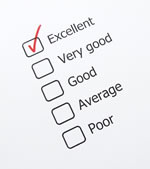Returning Students
You may also like:
Most Recent:
- GMP- Good Manufacturing Processes for food 2010.10.28 Good Manufacturing Processes for food
- HACCP Principle 4 - Establish Monitoring Procedures 2009.09.21 HACCP Principle 4 - Establish Monitoring Procedures
- HACCP Certification Training Home 2009.09.21 HACCP Certification Training Online
Approved Course

Applying HACCP Principles™ For The Food Service Industry has been Reviewed and Accredited by the HACCP Alliance as meeting the required standards for content and training for introductory HACCP.
Bookmarks & Feeds
News:
HACCP Wireless Refrigeration Monitoring System
HACCP Wireless Refrigeration Monitoring System requires no PC or software
HACCP Principle 4 - Establish Monitoring Procedures
Articles » HACCP Principle 4 - Establish Monitoring ProceduresBy Gregory Scott McGuire

Now that you've established your Critical Control Points and Critical Limits for every preparation process and every menu item in your restaurant, it's time to monitor.imits and CCPs don't do any good if there's no enforcement. The first thing to establish is someone who will accept responsibility for monitoring. If no one must answer directly for monitoring, then no one will actively enforce the managerial control points you have taken so much time to identify up to this point.
Of course you may want to have different people monitoring different CCPs. Regardless of who takes responsibility, proper training is an absolute must. Training ensures that monitoring processes are carried out accurately and effectively. Every CCP monitor should understand the following:
- What the Critical Limit is for each CCP under their control
- How to measure that Critical Limit (for example: how to properly take the temperature of a cooking chicken breast)
- Where to find and how to calibrate measurement equipment like thermometers
- How often to monitor
The CCP, Critical Limit, and the procedures on when, how, and where to monitor should all be written down in clear procedures that the person in charge of monitoring has read and signed. This helps prevent confusion and assigns official responsibility, which is particularly useful in case of problems down the road.
An example set of guidelines for a specific menu item might proceed as follows:
Menu Item: Chicken Parmesan
Assigned to Process 2 (this restaurant cooks once then immediately serves this menu item)
Identified Prerequisite Program Controls:
- Supplier verification
- Receiving temperature
- Cold storage temperature
- Employee hygiene (handwashing, hair nets, bare hand contact, etc.)
- Cross contamination (color coded cutting boards and knives, etc.)
Identified CCPs:
- Cooking temperature
- Hot holding temperature or using time
The Critical Limits Are:
- 165 degrees Fahrenheit for 15 seconds for cooking the chicken breast
- Serve immediately
Note that this particular restaurant serves their Chicken Parmesan immediately, thus using time as a way to control the return of bacterial growth. If the restaurant did not plan on serving the chicken immediately, then a hot holding Critical Limit of 135 degrees Fahrenheit would need to be in place.
So someone in your restaurant needs to be trained and accept responsibility for monitoring the chicken breast while it cooks and ensure that it is regularly hitting 165 degrees Fahrenheit for 15 seconds. It is up to you to establish the guidelines for the frequency of the monitoring. The restaurant in this example tests one chicken breast in the beginning of the dinner shift, one in the middle, and one at the end of the rush to ensure temperature Critical Limits are being met. Consult with your local Board of Health while you are developing your own guidelines.
Gregory Scott McGuire is a regular contributor to The Back Burner Blog, a resource of restaurant news and trends written by the employees of Tundra Specialties, a company specializing in restaurant equipment, supplies, and equipment parts
Write a comment